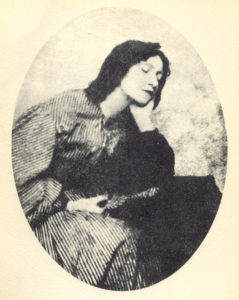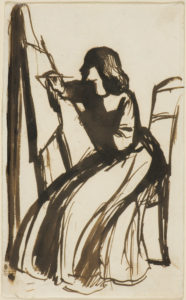25 July 1829 – 11 February 1862
Oh, how much I love Lizzie. I have been a massive fan of hers since I was but a wee college student first discovering the Pre-Raphaelite Brotherhood (PRB) back in the last century. I even wrote my senior thesis on Lizzie and her sister-in-law Christina Rossetti.
 She is best known as the model who lay in a lavish dress in an ever-colder bath full of flowers while John Everett Millais painted his famous Ophelia, a professional decision on her part that led to a very bad cold or perhaps pneumonia. Her father rightfully extracted the doctor’s fees from Millais.
She is best known as the model who lay in a lavish dress in an ever-colder bath full of flowers while John Everett Millais painted his famous Ophelia, a professional decision on her part that led to a very bad cold or perhaps pneumonia. Her father rightfully extracted the doctor’s fees from Millais.
Family legend claimed high-born ancestors, a romantic idea of being better than their circumstances and being brought low by past injustices, but at least in Lizzie’s lifetime, the Siddals were working class, her father a cutlery maker. She herself was discovered working at a dressmakers and millinery shop in London when (and the story has different versions) Arthur Deverell or his father thought she’d be a good model.

Through Deverell, Lizzie met the rest of the PRB and began modelling for other artists, among them Millais and William Holman Hunt and, of course, her eventual husband Dante Gabriel Rossetti.
Her life was absolutely romantic, full of tragedy and drama, and has been the subject of many books and various media adaptations. I recommend the Wikipedia article on her as an excellent introductory review of the facts of her life.

NMH 18/2007
Though her fame primarily derives from her work as a model and from being the paramour and eventual wife to the poet and painter Dante Gabriel Rossetti, Lizzie dreamed of pursuing her own career as an artist and some of her work survives and is held in various museum collections. It is hard to know what she might have been able to do had she been trained seriously from her youth as her husband and the other PRB members were, but I feel her work fits in nicely with her PRB contemporaries, her choices falling closer to the clean lines and compositions of the medieval art that inspired the group than her husband’s more florid style. Her work had its supporters during her life, and she received a bit of critical acclaim and even exhibited her work with the PRB in 1857. In recent years, her work has seen a reassessment on its own merits and been the subject of at least two solo retrospective exhibitions.

Her relationship with Rossetti eventually led to marriage, but the road there was rocky. She suffered from chronic ill health, and he was fickle and inconstant. Much of the ongoing drama of their on-again, off-again romance was likely due to her status as a woman in the Victorian Era. As much as she wanted and worked to be an artist and poet in her own right, she had not the social standing, support system, or money to live independently without a husband. Having been in such a long-term and well-known relationship with him, one that including living together for several years, their never marrying would have meant disaster for her. This is less in the sense of social ruin than it was about having a support system. She had made friends and had her own network beyond her relationship with Rossetti, but especially considering her health issues and lack of family fortune, supporting herself without a marriage to Rossetti would have meant relying on the charity of these connections in a way that was not likely sustainable.
Rossetti’s family was of a higher social class than Lizzie’s as well and their disapproval of her as a wife for Rossetti played a role in his putting off the marriage. Her ill health and depression almost certainly were caused or exacerbated by the precarious nature of her relationship with Rossetti as the years passed and no marriage took place. But they did marry finally, eight years after they first moved in together (and after much drama and breaking up and coming together again), but the marriage only lasted three years.

Tragically, Lizzie died 159 years ago today from a laudanum overdose when she was 32 years old, a death that did not end the drama attached to her name or her relationship with Rossetti.
Still, I think they did love each other even if I think both would have been better off to have never met.
When my friends and I visited Highgate in the spring of 2018, the tour guide asked if there were any special graves we wanted to see and my hand shot up like Hermione’s which was good because the Rossetti family tomb was not on the regular tour.
As an American used to American cemeteries, it’s a bit odd to see how overgrown even such major city cemeteries as Highgate are allowed to be. You can see through the fence on the East side as you’re walking to the entrance gate where the trees have overwhelmed old headstones, ensnaring them past anyone getting even close. The Rossetti tomb where Lizzie is buried is back in a fairly overgrown area on the West, the headstone itself worn down and hard to read and looking about to disappear into the undergrowth.
RIP Lizzie
Please visit my Instagram for any questions or comments on this post!
*There are multiple copies of Beata Beatrix in existence. The original is pictured above and was done posthumously in memoriam for Lizzie who is the model for Beatrice. This one hangs in the Tate in London. Another version done by Rossetti on commission with a custom frame and extra panels is in the collection of the Art Institute of Chicago, and I visit it whenever I get the chance.
See more works by Lizzie and works for which she modeled at the Tate website.
